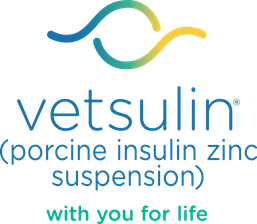

Managing Diabetes Complicated by Ketoacidosis
Read More About Feline Diagnosis & Management
Diabetic Ketoacidosis (DKA) is Potentially Life-Threatening
If diagnosis is found in cats, this complication of diabetes mellitus has to be aggressively treated.
Diagnosis
Diagnosis is based on the presence of ketonuria with clinical signs.
Management Guidelines
Goals of treatment for diabetic ketoacidosis include correcting fluid deficits and acid-base and electrolyte imbalances, reducing blood glucose and ketonuria, initiating insulin therapy, and treating concurrent diseases. The use of intravenous fluid therapy with isotonic fluids to correct fluid deficits and acid-base and electrolyte imbalances is recommended.
Many protocols for treatment of DKA exist but IV fluids and rapid-acting insulin (regular) must be administered first to quickly decrease hyperglycemia. Once the blood glucose has decreased to 250 mg/dL using regular insulin, it is important to add dextrose to the fluids and continue with regular insulin until the cat is no longer vomiting, is eating, and no longer has ketones in the urine. At this point, the regular insulin along with the dextrose in the fluids can be discontinued and Vetsulin® (porcine insulin zinc suspension) therapy can be initiated.
Evaluation of Treatment
When evaluating the regulation of insulin therapy, it is important to consider several areas including the evaluation of glycemia, urine monitoring, routine re-checks and glycated protein evaluations.
Evaluation of Glycemia
Creating a blood glucose curve is the most accurate way to evaluate glycemia to adjust the Vetsulin dose.
Indications for creating a blood glucose curve are:
- First, to establish insulin dose, dosing interval, and insulin type when beginning regulation.
- Second, to evaluate regulation especially if problems occur.
- Third, when you suspect rebound hyperglycemia (Somogyi effect).
Contraindications for creating a blood glucose curve are:
- Concurrent administration of drugs affecting glycemia.
- Presence of a known infection or disease.
- Stressed animal.
The Response Procedure
The most accurate way to assess management response is to generate a blood glucose curve. Ideally, take the first blood sample just prior to or immediately following the first Vetsulin administration. Thereafter, take blood samples every 2 hours throughout the day for 12 hours.
For punctual blood glucose measurements, collect single blood samples late in the afternoon, shortly before the second meal is fed. However, this is less precise as some problems could be missed (eg, Somogyi overswing). For this reason, it is not recommended to increase the dose of Vetsulin based on a single blood glucose sample (spot check).
Urine Monitoring
Urine only tests positive for glucose if the blood glucose concentration remains above the renal threshold for a substantial period of time. Therefore, urine monitoring is not a very reliable method by which to adjust a cat’s insulin dose and should only be used when it’s impossible to take blood samples or to monitor for ketones in the urine.
Routine Re-checks
After you’ve successfully stabilized the pet, do routine re-checks at regular intervals of 2 to 4 months. Re-check evaluations sometimes reveal slight hypo- or hyperglycemia and if all other parameters (urine, appetite, water uptake, general conditions, etc.) are normal, repeat glucose testing the following day is recommended before making any dose adjustment.
Glycosylated Proteins
Measurement of the glycosylated proteins serum fructosamine (SF) and glycosylated hemoglobin (HbA1c) is another way to evaluate regulation. The level of these proteins reflects the chronic hyperglycemia characteristic of diabetes mellitus and is not affected by stress, medication, or recent feeding. SF is most frequently used and reflects the mean blood glucose for regulation for 2 to 4 weeks before the blood sampling. This test is available through most diagnostic laboratories, and results should be interpreted according to each laboratory’s guidelines. A new dried blood spot, mail in test is available for testing HbA1c in cats as well.
Help Your Practice Manage Diabetes Mellitus
Check out these tools and resources to help manage feline diabetes.

Blood Glucose Curve Generator
Create a blood glucose curve to monitor and evaluate diabetes treatments.

Client Discharge Form
Create a customized, printable form for clients about their new diagnosis.

Diabetes Resources
Access online tools and more to support staff and pet parents.
No items to show.
Read More About Feline Diagnosis & Management
Important Safety Information:
Vetsulin® should not be used in dogs known to have a systemic allergy to pork or pork products. Vetsulin is contraindicated during periods of hypoglycemia. Keep out of reach of children. As with all insulin products, careful patient monitoring for hypoglycemia and hyperglycemia is essential to attain and maintain adequate glycemic control and prevent associated complications. Overdosage can result in profound hypoglycemia and death. The safety and effectiveness of Vetsulin in puppies, breeding, pregnant, and lactating dogs has not been evaluated. See package insert for full information regarding contraindications, warnings, and precautions.
References:
1. Martin GJ, Rand JS. Pharmacology of a 40 IU/ml porcine lente insulin preparation in diabetic cats: findings during the first week and after 5 or 9 weeks of therapy. J Feline Med Surg. 2001;3(1):23–30. 2. Vetsulin® (porcine insulin zinc suspension) [Freedom of Information Summary]. Millsboro, DE: Intervet Inc.; 2008. 3. Data on file, Merck Animal Health. 4. Graham PA, Nash AS, McKellar QA. Pharmacokinetics of porcine insulin zinc suspension in diabetic dogs. J Small Anim Pract. 1997;38(10):434–438. 5. Martin GJ, Rand JS. Pharmacokinetic and Pharmacodynamic Study of Caninsulin in Cats with Diabetes Mellitus. 2000: Internal Study Report. 6. Feldman EC, Nelson RW. Canine and Feline Endocrinology and Reproduction. 3rd ed. St. Louis, MO: Saunders; 2004:539–579. 7. Tennant B, ed. BSAVA Small Animal Formulary. 4th ed. Gloucestershire, UK: British Small Animal Veterinary Association; 2002. 8. Feldman EC, Nelson RW. Canine and Feline Endocrinology and Reproduction. 3rd ed. St. Louis, MO: Saunders; 2004:486–538. 9. Reusch C. Feline diabetes mellitus. In: Ettinger SJ, Feldman EC, eds. Textbook of Veterinary Internal Medicine. 7th ed. St. Louis, MO: Saunders; 2010:1796–1816. 10. Nelson RW. Canine diabetes mellitus. In: Ettinger SJ, Feldman EC, eds. Textbook of Veterinary Internal Medicine. 7th ed. St. Louis, MO: Saunders; 2010:1782–1796. 11. Burgaud S, Riant S, Piau N. Comparative laboratory evaluation of dose delivery using a veterinary insulin pen. In: Proceedings of the WSAVA/FECAVA/BSAVA congress; 12–15 April 2012; Birmingham, UK. Abstract 121. 12. Burgaud S, Guillot R, Harnois-Milon G. Clinical evaluation of a veterinary insulin pen in diabetic dogs. In: Proceedings of the WSAVA/ FECAVA/BSAVA congress; 12–15 April 2012; Birmingham, UK. Abstract 122. 13. Burgaud S, Guillot R, Harnois-Milon G. Clinical evaluation of a veterinary insulin pen in diabetic cats. In: Proceedings of the WSAVA/FECAVA/BSAVA congress; 12–15 April 2012; Birmingham, UK. Abstract 45. 14. Davison LJ, Walding B, Herrtage ME, Catchpole B. Anti-insulin antibodies in diabetic dogs before and after treatment with different insulin preparations. J Vet Intern Med. 2008;22:1317-1325. 15. Banfield State of Pet Health 2016 Report. p 12-13.
